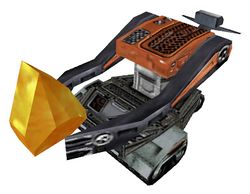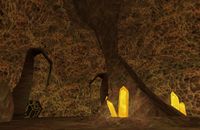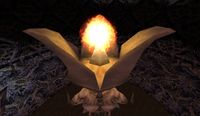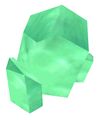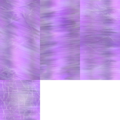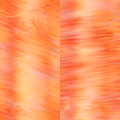Xenium
- "Any ideas on the origin of that new sample?"
- ― Black Mesa scientist[src]
Xenium,[1][2] (pronounced “zenium”) colloquially known simply as Xen crystals,[3][4] is a crystalline mineral structure of exotic matter, unique to the alien borderworld Xen.
Overview[edit]
The environments within Xen commonly have clusters of crystals of varying sizes and shapes dotting the landscapes. The Black Mesa science team use them in the research and development of teleportation technology. They emit a bright aura, providing natural lighting to the areas surrounding them. They are typically colored yellow or green, although purple crystals are also witnessed in the facility being used in tests.
Appearances[edit]
Half-Life[edit]
In Half-Life, Black Mesa sent numerous survey teams to Xen to collect crystal samples, acquiring several specimens in the process intending to further examine their unique properties. After studying Colette Green's report on the acquired crystals, the senior science team staff decided to replace the EP-0021 specimen with GG-3883, named after the survey team that gathered it, in their forthcoming simulation as they found it to be the purest and largest sample yet discovered. However, it was also feared to be highly unstable.[5]
It is Gordon Freeman's role in the test chamber to insert the GG-3883 crystal sample into the Anti-Mass Spectrometer. On the day of the experiment, the scientists boost the analyzer to get a conclusive analysis of the sample, which is a deviation from the standard analysis procedures. Pushing the Materials Handler that holds the sample into the analyzer triggers a quantum event called a resonance cascade. This opens a dimensional rift between Earth and Xen.
In the final confrontation of the game, the Nihilanth's chamber features large triangular crystal structures embedded into the walls that are surrounded by beams of energy. When the Nihilanth is injured, it draws power from the crystals to rejuvenate itself. Its health is represented by a ring of glowing spheres encircling its head which are transferred from the crystal structures. When these crystals are ultimately destroyed by Gordon, the creature finally becomes vulnerable.
Half-Life expansions[edit]
In Opposing Force, Adrian Shephard enters the Hydrofauna Studies Laboratory and must travel through a partially malfunctioning teleporter that is visibly powered by two Xen crystals. When the device is activated, the crystals are initially unable to focus inside the teleport chamber and end up inadvertently teleporting portions of the nearby equipment. At the conclusion of the game, Shephard is required to use mounted laser guns powered by crystals to defeat the final boss, the Gene Worm.[6] These weapons were presumably created by scientists who were struggling to deal with the situation that unfolded[7] and placed on the catwalks by the Marines who preceded Shephard.[6]
In Blue Shift, Barney Calhoun and his associates need to make use of the old teleporter equipment in the Section A-17 Prototype Labs in a plan to escape the facility, but the equipment does not have the ability to target an Earth destination in its current state. Dr. Rosenberg explains that the borderworld is involved during the teleportation process and had previously prevented them from accurately predicting where any teleport event would lead to back on Earth. To counter this, they discovered they could build a device which attached to the realm's strange crystalline structures which allowed them to create a focal point and relay that aided in the teleportation. Barney is sent to Xen to activate one such device to fulfill their plan.
In Decay, Gina Cross delivers the GG-3883 crystal sample to an elevator platform that transfers it to Gordon in the test chamber above. Much later, after the resonance cascade has occurred, she and Colette Green need to work together to power the Displacement Beacon by going to the Alien Quarantine Labs and activating a beam matrix, a device powered by an array of multi-colored crystals. After this, the duo must use the beacon's focus emitter to charge up large crystals situated in the surrounding canyon walls, those resembling the ones seen in the Nihilanth's chamber. This act initiates a resonance reversal sequence meant to seal the dimensional rift between the worlds. In the bonus mission, Xen Attacks, two Vortigaunts are sent to Earth by the Nihilanth to retrieve a container of stolen crystals.
Half-Life 2 and its Episodes[edit]
In Half-Life 2, when Gordon arrives at Black Mesa East, Eli Vance shows him a miniature resonance cascade emulation powered by a small crystal in a machine called the Rotato.[8] The player can interact with the machine and rotate the crystal to examine it. In Episode Two, Eli Vance reveals that the crystal sample that triggered the Black Mesa incident was brought to them by the G-Man.
At the conclusion of Episode Two, the Resistance uses a device called the Xenium resonator to neutralize the superportal. The device, which is presumed to be attached to the rocket launched at White Forest, is activated when the satellite is in range of the portal.
While it had never been suggested prior, The Final Hours of Half-Life: Alyx indicates that Gordon's Gravity Gun is powered by a Xen crystal. They're able to "grow" crystals large enough for this purpose, and this element is said to be what allows the device to lift and pull objects.[4]
Half-Life: Alyx[edit]
Although not able to be physically seen, the watch case on Alyx's Gravity Gloves is said to contain a tiny shard of a Xen crystal, the same kind used for the Gravity Gun and thus affording it similar capabilities. At this point in the storyline, it's said only small coin-sized crystals can be grown.[4]
Behind the scenes[edit]
According to series writer Marc Laidlaw, Xenium was named after the similar crystals found in his Gadget tie-in novel, The Third Force: A Novel of Gadget, which he wrote before joining Valve.[1][2]
The initial crystal sample seen in the test chamber was meant to be clearly echoed by the crystals witnessed in the Nihilanth's chamber and even by the triangular prong found inside the being's head. However, the development team ran out of time to make the clear visual association.[9] Purple and orange crystal textures were created but never used in Half-Life. The purple variation can be found in Decay. In the internal developer notes for the Half-Life Alpha version 0.61, the "What Not to Talk About" section states that they could show images of their planned purple crystal to the public before the game's release but must refrain from explaining its purpose in regards to its puzzle-solving aspect.[10] No preview images displaying this purple crystal were ever released.
A document written by Marc Laidlaw late in Half-Life's development offers additional backstory information for the crystals. In a concluding summation of the game's ending, Black Mesa is said to have been deliberately pointed towards Xen from the beginning. They were directed there by a certain element, implied to be the crystal sample originating from Xen itself, which had become part of their portal's tuning mechanism. They had received the sample under the pretense that it was a man-made compound created in a separate secret research facility, but in truth, it was surreptitiously delivered to them by mysterious intelligent alien races which intended to test humanity's own capabilities.[11]
The green-colored crystals only appear in the chapter Gonarch's Lair in Half-Life. These were replaced with their yellow counterparts in the console ports of the game. The texture light file for the map c1a0d (the chapter Anomalous Materials) contains information referencing one of the unused green crystal textures (crys_2top), suggesting it was present in the map at one point.[12] There is an unused yellow crystal model (crystal.mdl) in the files which has a single animation showing it idly rotating in place. It is slightly larger than an average human character. The model is named tele_crystal in the Half-Life: Source files.
In the Half-Life 2 leak, a sounds folder titled "kleiner_teleport" contains unused dialog files dated from February 2002 for an early version of the teleportation sequence that plays out in Kleiner's Lab. In this version, as a reference to the test chamber scene from the original game, Kleiner instructs Gordon to climb up a ladder and manipulate a crystal insertion device, described as crane-like equipment, to start the process of powering up the teleporter. No built iterations of the scene associated with these lines are present in the leak. The final version of this sequence makes no mention of using a Xen crystal.
Gallery[edit]
Half-Life[edit]
Half-Life: Opposing Force[edit]
Crystal on the same rock formation as a Race X portal.
Crystals briefly witnessed by Adrian Shephard during the ending Osprey ride.
Half-Life: Blue Shift[edit]
Half-Life: Decay[edit]
L.M.'s memo to Colette Green.
Half-Life 2[edit]
A crystal in Eli's Lab at Black Mesa East.
Half-Life: Alyx[edit]
List of appearances[edit]
Main games[edit]
- Half-Life
- Half-Life: Opposing Force
- Half-Life: Blue Shift
- Half-Life: Decay
- Half-Life 2
- Half-Life: Alyx
Other[edit]
- Half-Life: Day One (First appearance)
References[edit]
- ↑ 1.0 1.1 Marc Laidlaw on Xen Crystals being named Xenium (February 4, 2017)
- ↑ 2.0 2.1
 Tweet: "BTS tip: The first appearance of xenium, the orange crystal from Xen, is in this book. A proto-G-man also." @marc_laidlaw (Marc Laidlaw) on Twitter (September 8, 2017) (archived)
Tweet: "BTS tip: The first appearance of xenium, the orange crystal from Xen, is in this book. A proto-G-man also." @marc_laidlaw (Marc Laidlaw) on Twitter (September 8, 2017) (archived)
- ↑ Half-Life: Decay, Xen Attacks mission completion message: "Xen crystals recovered."
- ↑ 4.0 4.1 4.2 The Final Hours of Half-Life: Alyx, Chapter 9
- ↑ Half-Life PlayStation 2 instruction manual
- ↑ 6.0 6.1 Half-Life: Opposing Force Prima Guide
- ↑ Kristy Pitchford on laser guns powered by the crystals (September 29, 2016)
- ↑ Half-Life 2 Prima Guide
- ↑ Interview with Marc Laidlaw on loonygames (1999) (archived)
- ↑ Half-Life Alpha (version .61) Notes (
Half Life Main v6.doc) (August 26, 1998) - ↑ "Nihilanth" on Marc Laidlaw's personal website (October 3, 2016)
- ↑ Half-Life SDK (
Map Files/c1a0d.rad)
